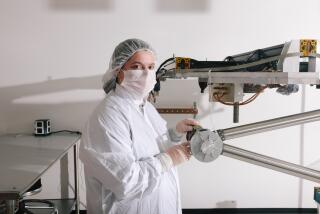Frost on Mars? Curiosity uses its laser to probe mystery (#PewPew)
The Mars Curiosity rover, cozy at the sandy, windblown patch of ground called Rocknest, pulled out its laser late last week, aimed it at a target about 9 feet away and started zapping.
The goal? To find out whether frost accumulates on Mars’ surface at night, according to Roger Wiens of Los Alamos National Laboratory.
“The idea was to take one measurement of Crestaurum at night and one during the day for comparison,” the scientist and principal investigator for Curiosity’s ChemCam instrument told the Los Angeles Times.
SPACE QUIZ: Blue moons, shooting stars and more
The mast holding the laser was left pointing all night at the sandy target dubbed Crestaurum, he said. The fierce Martian cold makes the mast’s joints immovable without expending quite a bit of energy to heat them.
A combination of images produced the blinking picture above to reveal the dark pit opened up by the laser.
The Curiosity rover Twitter stream amused followers with Monday’s tweet: “#PewPew! I zapped a Martian sand target 30 times. Analysis underway...”
Crestaurum is on the opposite side of the Rocknest dune from where Curiosity is scooping up dirt for its other instruments, according to Wiens. It was important to do the frost study now, he said, while the Martian seasons were cooperating.
“The Gale Crater site, which is 4 degrees south of the equator, is currently in early spring,” he said. “Both day and nighttime temperatures are getting warmer. It was important that we carry out this study while it is still early in spring.”
The side of the Rocknest dune that Curiosity zapped has finer sand, he noted, which has “a large amount of surface area so it might have more frost than a solid surface such as on a rock.”
Wiens said late Monday that the team was still awaiting the results of its frost study.
NASA’s Guy Webster told The Times that Curiosity, for part of this week, will be working with its fourth scoop of Mars soil.
“The team plans to collect and analyze at least one more at this patch called Rocknest,” he said.
“These are the first solid materials going into the internal analytical instruments that are the core of the science capabilities for this mission. A few weeks from now, these same instruments may be getting their first samples of powder drilled from the inside of a Martian rock.”
ALSO:
Astronauts bond with each other, their spacesuits
Girl mistaken for skunk at Halloween party shot by relative
Douglas Kennedy, RFK son, on trial in child endangerment case
More to Read
Sign up for Essential California
The most important California stories and recommendations in your inbox every morning.
You may occasionally receive promotional content from the Los Angeles Times.











